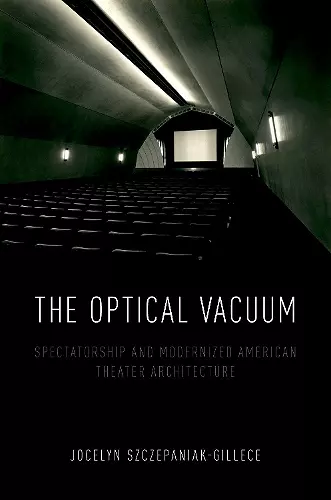The Optical Vacuum
Spectatorship and Modernized American Theater Architecture
Jocelyn Szczepaniak-Gillece author
Format:Paperback
Publisher:Oxford University Press Inc
Published:27th Sep '18
Currently unavailable, and unfortunately no date known when it will be back
This paperback is available in another edition too:
- Hardback£91.00(9780190689353)

This insightful exploration of architectural evolution in cinema highlights Benjamin Schlanger's influence on immersive film viewing in The Optical Vacuum.
Examining the evolution of American cinematic architecture from the 1920s to the 1960s, The Optical Vacuum explores the transformative role of architect Benjamin Schlanger. His innovative designs and thought-provoking essays played a crucial role in reshaping the experience of film viewing. As movie theaters transitioned from grandiose palaces to more intimate, streamlined environments, Schlanger's influence became paramount in creating spaces that facilitated immersive watching experiences.
The book delves into the concept of the 'neutralized space,' where the design of movie theaters was specifically tailored to enhance the spectator's experience. By analyzing Schlanger's work, The Optical Vacuum highlights how architectural choices impact the way films are perceived and enjoyed. It argues that the essence of film viewing is deeply intertwined with the physical spaces in which movies are presented, suggesting that our understanding of cinema is shaped not just by the films themselves but also by the environments in which they are shown.
In this insightful exploration, the text connects the evolution of theater design to changing patterns of spectatorship. From the lavish decorations of the movie palace to the minimalist black box of contemporary auditoriums, The Optical Vacuum illustrates how these variations in design reflect broader transformations in cinephilia and audience engagement. This book is an essential read for anyone interested in the intersection of architecture and film culture.
Szczepaniak-Gillece's book on exhibition history tells an utterly captivating and theoretically complex story of the architectonics of theatrical space and its impact on spectatorial attention and absorption. The Optical Vacuum makes a stunning contribution to the vibrant field of Screen Studies, arguing that design can never be divorced from the viewing experiences imagined by cinephiles as well as the doyens of modernism. * Alison Griffiths, The City University of New York *
Movie theaters are not just places to see a film. They are sites in which to experience new technologies, explore immersive environments and to innovate new modes of seeing and hearing. This fascinating book shows us that movie theaters have long been irretrievably shaped by dynamic debates across fields such as modernism, architecture, design, and commercial entertainment, inviting us to look beyond the screen and at the spaces in which movies have long been embedded. This book is essential reading for those interested in the history of theaters and cinema, as well as those interested in modernity, entertainment, and the persistent transformation of the human senses by technological design. * Haidee Wasson, Concordia University *
ISBN: 9780190689360
Dimensions: 155mm x 231mm x 15mm
Weight: 363g
210 pages